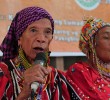Coalition work
Because the union he was leading was composed of numerous shops with local unions, Olalia clearly grew to appreciate the value of coalescing with other workers and unions in the Philippines to further strengthen their campaign leverage. In 1939, he helped organize the militant Katipunan ng mga Anakpawis (KAP, Association of the Toiling Masses) and was elected its general secretary. Then he took part in the all-out campaign to unite labor; they formed the Collective Labor Movement (CLM) where he was elected Vice-President.
At the time of the U.S. colonial government, then the puppet commonwealth government, and then today�s puppet (though supposedly sovereign) government, trade union repression was (and still is) the government�s standard reaction, later coupled with nurturing yellow unionism to divide the traditionally militant and nationalist unions and to confound the masses of workers. Since the U.S. colonial government began training and coddling local yellow union leaders, uniting the Filipino labor movement has become a sort of a holy grail to genuine and militant unionists.
In the history of the Philippine labor movement, Olalia proved the most indefatigable in striving to cobble together the broadest possible coalition of working people. When CLM failed, he and other labor leaders organized the Manila Labor Council in 1940 where he was elected general secretary.
The outbreak of World War II merely stoked Olalia�s desire for freedom. Becoming a member at last of the Communist Party of the Philippines (now referred to as the �old� party) which had been established a decade earlier by elder stalwarts of the labor movement like Crisanto Evangelista, Olalia�s energies became more fruitfully devoted to organizing, and this time, to armed guerrilla warfare as well.
As designated secretary of Manila-Rizal, he delivered in organizing the area. Before the Japanese troops invaded the Philippines, he also trained at guerilla warfare in Nueva Ecija and upon his return to Manila, was recruited by the Allied Intelligence Bureau to its service, knowing full well that he is also a member of the Hukbalahap (Huk, People�s Army Against the Japanese).
Olalia served as commander of Hukbalahap�s Manila squadrons, but he had to organize at least three squadrons of fighters first, who mostly came from organized workers.
Ideological battles of the looked-down upon self-taught intellectual
Olalia reached only Grade IV but it did not stop him from reading academic heavyweights such as the political-economic treatises of Karl Marx and Vladimir Lenin, which Crisanto Evangelista would lend him, or which Olalia himself had bought out of his meager earnings as a shoe worker. He was soon able to build up a considerable library.
But just like Andres Bonifacio, Olalia had been haunted by his low formal educational attainment even in his own field of workers� organizations. To the courageous and proud man it must have rankled, as in fact he�d candidly admitted to having been hurt in an interview in 1980 with journalist Pete Lacaba, where he said:
�Though it hurts to say it, it�s unfortunately the truth� I�m (just) a worker, and no one had imagined that a worker like me may one day become a mass leader or a participant in theoretical discussions on Marxism.� (Olalia was trying to explain why a few intellectual leaders from the Newspaper Guild sided with Amado V. Hernandez while most of the workers sided with him in a misunderstanding that had not even involved Hernandez within the Congress of Labor Organization in the late 1940s.)
Olalia had also been expelled twice from the old Communist Party due to disagreements with the Lava brothers� analysis of the Philippine political situation and their subsequent policies. First, when Olalia opposed the retreat-for-defense policy imposed by the Lavas who mistakenly believed the Filipinos were no longer fighting the Japanese troops; Olalia reported that it may be true for most USAFFE but not for the squadrons of Hukbalahap rebels who were still operating in many areas. Second, when Olalia vocally doubted the �See you in Malaca�ang� ambitions of the Lavas who believed that winning in the elections alone would sweep them in power.
History proved Olalia�s analyses and positions correct, but by then, while in the thick of forming bigger and broader labor organizations, he was already telling a doubtful Maj. Gen. Prospero Olivas that he is no longer a member of the erstwhile Communist Party. His achievements as labor leader wrote history for the Philippine labor movement, a feat which even the Department of Labor and Employment, in celebrating the centennial of the labor movement, honored in 2003.
After the Second World War, Olalia quickly resumed workers� organizing. Even if ��mopping-up operations� were still being conducted, he and other labor leaders in the newly formed CLO organized the first May 1 rally after the war in 1945. American security forces reportedly disarmed them of their placards, but they managed to conduct a program and even welcomed some GIs and WACs who joined them when the latter saw what remained of their May Day placards.










